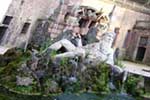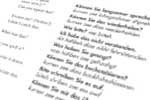university of heidelberg
History:
In 1386 Prince Elector Ruprecht I founded Heidelberg University, due in part to the Great Schism of 1378. It is the oldest university in present-day Germany and was modelled after the University of Paris, having its initial faculties in philosophy, theology, jurisprudence and medicine. The seal’s motto, “Semper apertus”, was chosen by the first rector and means “The book of learning is always open.”
Due to its open style of thinking and focus on humanism, the university quickly advanced into one of the leading universities in Europe. It was during this time that the Heidelberg Catechism was developed, and many of its alumni included bishops, chancellors and royal emissaries. Its prominence continued to grow until the Thirty Years’ War in 1618. During the war, the university’s renowned library, the “Bibliotheca Palatina” was stolen and taken to Rome. After this and the Wars of Succession in the late 1600s which destroyed most of the city, the university deteriorated, losing its stronghold in the academic world.
It wasn’t until 1803 when the Imperial Deputation Decree reorganized the German states, placing Heidelberg under the control of the Grand Duchy of Baden, that the university was revitalized. Prince Elector Karl Friedrich reenergized the university, renaming it "Ruperto-Carola", in honor of the two founders, and initiated the transformation back into a center of academic excellence. Many of Europe’s well-known scientists and philosophers spent time at the university, making it not only one of the leading scientific research centers in Germany, but also a center of democratic thinking.
With the arrival of the National Socialist party, however, the university once again fell into decline, losing many of its scholars and professors during the war. Luckily, though, the city was spared bombing, and so the university’s restoration following the war was much faster than many others, reopening its doors in 1946.
The university has continued to grow over the past 60 years, continually focusing on the humanities, natural sciences and medicine. Today, in addition to the university buildings that are spread throughout the Altstadt, there is also a large campus for medicine and natural sciences in the Neuenheim district, including one of the leading cancer-research centers in Germany.
Colleges at the University:
* Faculty of Theology (Theologische Fakultät)
* Faculty of Law (Juristische Fakultät)
* Faculty of Medicine (Medizinische Fakultät)
* Faculty of Philosophy and History (Philosophisch-Historische Fakultät)
* Faculty of Modern Languages (Neuphilologische Fakultät)
* Faculty of Economics and Social Studies (Fakultät für Wirtschafts- und Sozialwissenschaften)
* Faculty of Behavioural and Cultural Studies
* Faculty of Mathematics and Computer Science (Fakultät für Mathematik und Informatik)
* Faculty of Chemistry and Earth Sciences (Fakultät für Chemie)
* Faculty of Physics and Astronomy (Fakultät für Physik und Astronomie)
* Faculty of Bio Sciences (Fakultät für Biolowissnschaften)
* Faculty of Clinical Medicine in Mannheim (only for administrative reasons)
Renowned Alumni and Professors:
Arts & Humanities:
* Karl-Otto Apel, philosopher of discourse ethics
* Hannah Arendt, political theorist
* Auguste Beernaert, Belgian Prime Minister & 1909 Nobel Peace Prize
* Franz Boas, anthropologist
* Johann Eck, theologian
* Ludwig Feuerbach, philosopher
* Hans-Georg Gadamer, philosopher of hermeneutics
* Albert Gobat, politician, educator & 1902 Nobel Peace Prize
* Joseph Goebbels, Nazi propaganda minister
* Emil Gumbel, mathematician and pacifist
* Jürgen Habermas, critical theorist and philosopher
* Georg Wilhelm Friedrich Hegel, philosopher
* Karl Jaspers, existentialist philosopher-psychiatrist
* Ernst Hartwig Kantorowicz, historian
* W. Somerset Maugham, novelist
* Joseph von Eichendorff, poet and novelist
* Prof. Rev. Dr. Gerhard von Rad, Old Testament's expert scholar
* Max Weber and Alfred Weber, economists and sociologists
Science & Medicine:
* Walther Bothe, physicist &1954 Nobel Laureate
* Robert Bunsen, chemist
* James Frank, physicist & 1925 Nobel Laureate
* Philosopher Erich Fromm, psychologist
* Fritz Haber, chemist & 1918 Nobel Laureate
* Theodor W. Hänsch, physicist & 2005 Nobel Laureate
* Otto Haxel, co-inventor of the nuclear shell model
* Wolfgang Ketterle, physicist & 2001 Nobel Laureate
* Gustav Kirchhoff, physicist
* Leo Konigsberger, mathematician
* Albrecht Kossel, medical doctor & 1910 Nobel Laureate
* Richard Kuhn, biochemist & 1938 Nobel Laureate
* Philipp Lenard, physicist & 1905 Nobel Laureate
* Otto Fritz Meyerhof, physician and biochemist & 1922 Nobel Laureate
* Adolf Posselt & Reimann, chemists who discovered in 1828 that nicotine is the main pharmacologically active component of tobacco
* Sir William Ramsay, chemist & 1904 Nobel Laureate
* Bert Sakmann, cell physiologist & 1991 Nobel Laureate
* Otto Heinrich Warburg, physiologist and medical doctor & 1931 Nobel Laureate
* Ludolf von Krehl, medical pioneer
* Georg Wittig, chemist & 1979 Nobel Laureate
* Karl Ziegler, chemist & 1963 Nobel Laureate



